Traditional homes revitalized as specialty shops : Distinctly Korean designs have become stylish ways to spruce up a space
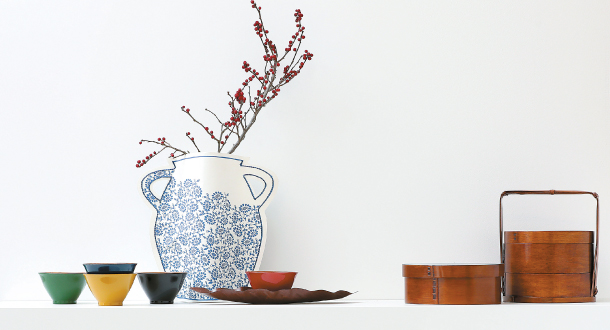
A flower pot cover sold at havebeenseoul is made of paper and decorated to look like a traditional white porcelain vase. [JOONGANG ILBO]

At left, a shopper explores the store, which is located inside an ordinary home. At right is a dagi (a traditional Korean tea set), which consists of a tea pot, a cup and a plate. [JOONGANG ILBO]
In the center of Gangnam, southern Seoul, sits a select shop filled with goods that are inspired and made by old-school materials such as hanji (Korean traditional handmade paper), jagae (the craft of inlaying mother-of-pearl) and sambe (hemp clothing).
Opened in November, havebeenseoul both exhibits and sells the work of artists who have interpreted the identity of Korea in modern ways. The shop offers some 100 pieces from both early-career artists and master artisans certified to craft items such as traditional folding fans or sedge works.
The building that houses the shop used to be a home. The owner of the shop chose not to renovate the house, so the structure of the living room and the dining room still remain.
As the space has not been reformatted to fit the goods the store sells, it perfectly highlights the concept of the store: to blend traditional items into people’s daily lives. Visitors can plainly see that the traditional goods naturally blend in with the modern and simple space of a house in the 21st century.
In the living room are a short-legged sofa and a table of the same height. On top of the table is a knife made of earthenware, a fountain pen with an inkwell and a handsome bookend.
A jagae-box, which is made out of special ingredients and requires a complicated production process, costs more than 2 million won ($1,882).
Nam Yeon-jung, the chief purchase officer, said, “People that are tired of similar kind of designs from abroad have been turning their eyes to the Korean styles. An ultra-niche market has been formed centering on those customers that are keen to find what they wish to buy.”
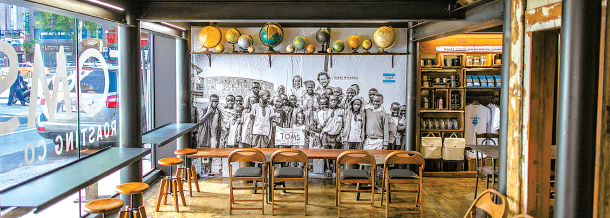
The spacious cafe gives a relaxing vibe. For every beverage consumed, the company sends fresh water to someone in need. [JOONGANG ILBO]
A hanok (Korean traditional house) cafe that opened last year in Naeja-dong, central Seoul, sells shoes and sunglasses in addition to various types of coffee. TOMS Roasting Co. is a cafe run by the American shoe brand TOMS.
Located on the road that leads to the Sajik Tunnel, the exterior of the cafe looks like a hanok with an exquisite roof laced with tiles.
When asked why the cafe was located in a hanok in the Seochon neighborhood, a staff member at the cafe said, “Because the brand is headquartered in California, which is considered to be the state with the most freedom in America, we thought that it [would be interesting to juxtapose that with] traditional Korean style. So we deliberately settled here to emphasize the contrast.”
The wooden pillars and the rafters of the roof catch the eyes of visitors as the qualities of the old hanok have been preserved quite well. An air conditioner was even installed behind a fake wall in order to not disturb the old-school atmosphere.
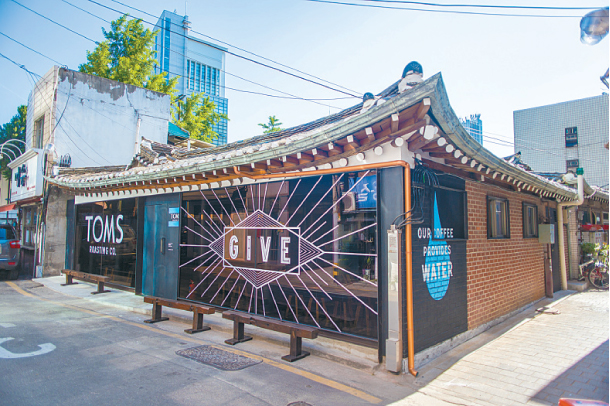
The qualities of a hanok (Korean traditional house) are preserved inside the cafe. In addition to beverages, shoes and sunglasses are on sale. [JOONGANG ILBO]
The shoe brand is known for its “One For One” ethos, and it provides a pair of shoes for a child in need whenever a pair is purchased.
Similarly, whenever a cup of coffee or tea is bought at TOMS Roasting Co., the company provides a day’s worth of clean water to someone in need.
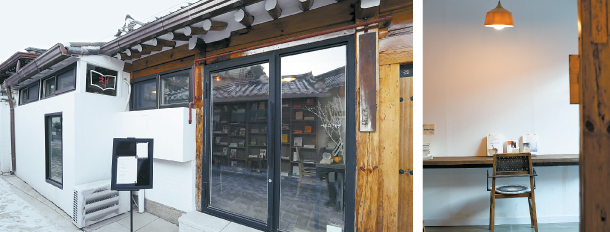
At left is the exterior of the bookstore, where passersby can see the bookshelves inside. At right is a reading space inside. [JOONGANG ILBO]
On the corner of the residential area in Seochon, central Seoul, a bookstore inside a hanok (Korean traditional house) opened last summer. Although there isn’t an eye-catching signboard outside, one can see the bookshelves through the glass.
Book curator Ha Young-nam, who runs Seochon It Books, has been leading a reading class with other bookworms for the past 20 years.
However, in July 2016, she suddenly quit all of her book gatherings. “Because I’ve been moving around here and there, I wanted to have my own space. So I decided to open a book store where I can sell books and open gatherings without having to have to move around,” said Ha.
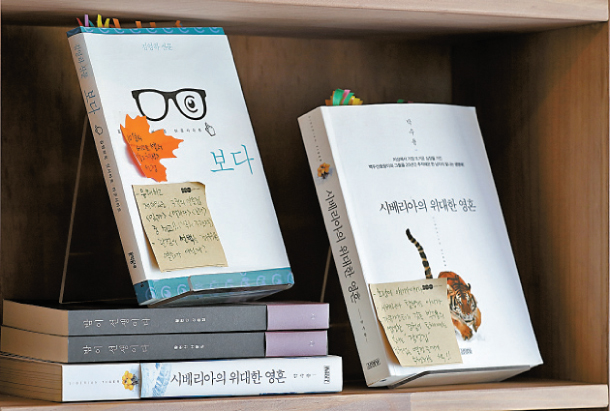
Every book on the shelf has a post-it attached, where Ha has written her one-sentence review of the book. [JOONGANG ILBO]
The interior of the hanok retains many traditional qualities and its original girders and rafters remain in the building’s ceiling. The entrance has been replaced with transparent glass so that the passersby can see the bookshelves from outside.
The books that Ha carefully selects attract people passing. Most of the books are written by Korean authors because she “wants to empower authors that write good stories.”
BY PECK SOO-JIN [hong.youkyoung@joongang.co.kr]
‘한국적인 것’에 꽂히다
전통 감각 새롭게 풀어낸 핫 플레이스 3
정겹고 푸근하거나, 촌스럽고 올드하거나. ‘한국적인 것’을 바라보는 시각은 대체로 둘 중 하나였다. 어머니 또는 할머니 세대의 취향으로 여겨지던 ‘전통미’가 감각적인 트렌드로 재조명받고 있다. 공예 디자인 편집 숍, 한옥 책방 등 한국적인 느낌을 내세운 이색 공간들이 속속 생겨난다. 입소문을 타고 있는 화제의 장소들을 둘러봤다.
해브빈서울 전통 공예 장인 100명을 만나다
강남 한복판, 역삼동 르메르디앙 호텔 뒷골목에 자개•옻•한지•삼베 등 전통 소재를 활용한 소품들로 가득한 편집 숍이 있다. 지난해 11월 문을 연 ‘해브빈서울(havebeenseoul)’이다.
한국적인 정체성을 모던하게 풀어낸 작가들의 작품을 전시하고 판매하는 공간이다. 신진작가부터 선자장(부채 장인)•완초장(왕골로 기물을 만드는 장인) 등 무형문화재까지 100여 명의 작품을 취급한다.
‘해브빈서울’이 들어선 건물은 직전까지도 사람이 살던 주택이다. 리빙룸과 다이닝룸의 느낌을 그대로 살렸다. 실생활에 전통디자인 소품이 어떻게 녹아드는지 보여주는 것이 이 공간의 콘셉트다. 모던하고 심플한 공간 속에 전통적인 디자인들이 위화감 없이 어울린다. 리빙룸엔 자유롭게 앉아 쉴 수 있는 소파와 낮은 테이블이 있다. 테이블 위에는 도자로 만든 페이퍼나이프와 만년필•잉크웰, 광화문을 형상화한 북엔드 등이 실제 사용 중인 물건처럼 놓여 있다. 재료를 구하기 어렵고 작업에 손이 많이 가는 자개함은 하나에 200만원이 넘는다. 다이닝룸은 식탁 위에 그릇•수저•다기 등 테이블웨어를 진열해 꾸몄다.
남연정 매니저는 “비슷한 수입 디자인에 질린 사람들이 한국적인 디자인으로 눈을 돌리고 있다”며 “원하는 사람은 꼭 찾아서 구매하는 ‘초니치(틈새의 틈새)’시장이 형성되고 있다”고 말했다.
탐스로스팅코 한옥 + 캘리포니아, 의외의 조합
지난해 서울 내자동에 생긴 한옥 카페에선 커피만 파는 게 아니라, 신발도 팔고 선글라스도 판다. 미국 캘리포니아 브랜드 ‘탐스’에서 운영하는 카페 ‘탐스로스팅코’다.
서촌마을 맞은 편, 경복궁역에서 사직터널로 가는 길목에 1층짜리 기와지붕 한옥을 개조해 만들었다. 탐스가 서촌의 한옥을 선택한 이유는 꽤 설득력이 있다. ‘탐스로스팅코’ 관계자는 “미국에서도 가장 자유분방한 캘리포니아 지역의 브랜드라 한국적인 것과 매칭이 안 된다고 생각했고, 그 대조되는 느낌을 의도한 것”이라고 설명했다.
오래된 한옥이 가지고 있던 특성을 거의 그대로 보존한 것이 눈에 띈다. 외관뿐 아니라 내부의 나무 기둥, 서까래 등도 살렸다. 천장에 에어컨을 달면 느낌을 해칠까 봐 벽으로 뺐다. 가게 전면은 통유리로 바꿔 브랜드 로고 등을 입혔지만 벽면에는 옛날 나무 창문을 두었다. 얼룩덜룩한 벽은 시공 과정에서 기존 벽지를 뜯어낸 것을 그대로 둔 것이다.
테이블을 듬성듬성 놓아 공간은 여유롭다. 커피 맛도 좋다. 공정무역과정을 통해 생산된 스페셜티급 원두를 한국에서 로스팅하여 제공한다. 커피 원두는 에스프레소 2종(카르페디엠 서울•써밋)과 싱글 오리진 3종(콜롬비아•페루•에티오피아) 등 총 5종이다.
탐스 신발을 한 켤레 사면 신발이 필요한 또 다른 이에게 한 켤레가 기부되는 ‘원 포 원(One for one)’ 캠페인은 이곳에서도 적용된다. 음료를 한 잔 마실 때마다 도움이 필요한 사람들에게 깨끗한 물이 기부된다.
서촌, 그 책방 한옥의 포근함 속에서 책을 읽다
서촌의 주택가 골목. 어느 기와집 나무 대문 옆에 숨은 듯 딸린 바깥채에, 지난해 여름 책방이 하나 들어섰다. 눈에 띄는 간판은 없지만 걸음을 느리게 하면 유리문 너머로 정갈하게 진열된 책장이 보인다.
‘서촌, 그 책방’의 주인장 하영남 대표는 독서광인 데다 감상과 토론을 좋아해 20여년간 책을 좋아하는 사람들을 모아 독서지도와 독서모임을 주도했다.
재작년 7월, 돌연 독서모임을 모두 멈췄다. “여기저기 옮겨 다니며 모임을 하다 보니 나만의 공간을 갖고 싶어졌어요. 책을 팔면서 안정적으로 책 읽기 모임을 할 수 있는 공간을 만들기로 했죠.”
하 대표는 “한국적인 아름다움은 한국인이 본능적으로 이해할 수 있는 영역”이라고 말한다. 우리 삶 속에 녹아 있는 미술•건축•문학 모든 것이 하늘에서 뚝 떨어진 게 아니기 때문이다. “한국에서 태어나 자라면서 향유해 온 모든 것들이 우리 안에 있어요. 본능적으로 포근함을 느끼는 공간에서 책을 소개하고 함께 읽고 싶었어요.”
인테리어는 한옥 느낌을 최대한 살렸다. 벽은 모두 희게 칠했지만, 서까래•대들보 등 목조 골격은 그대로 남겼다. 출입문은 유리로 했다. 바깥에서 들여다보이는 벽면은 전면이 책장이다. 하 대표가 엄선한 책들은 그 자체로 광고판이다. 책은 대부분 한국 저자 위주로 선정한다. 좋은 글을 쓰는 우리 작가들에게 힘을 실어주고 싶어서다
백수진 기자










with the Korea JoongAng Daily
To write comments, please log in to one of the accounts.
Standards Board Policy (0/250자)